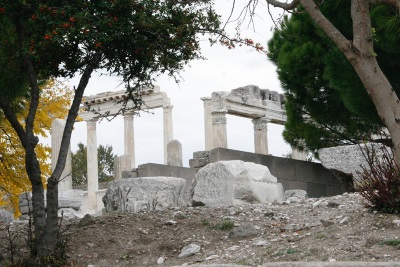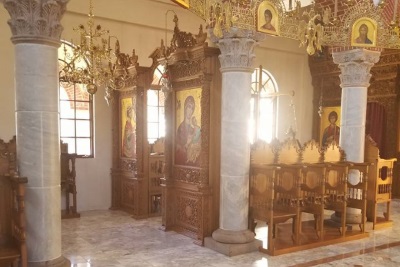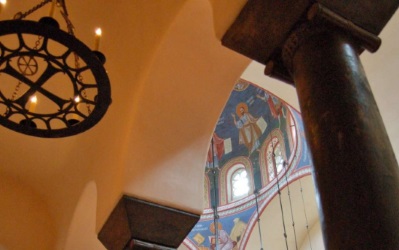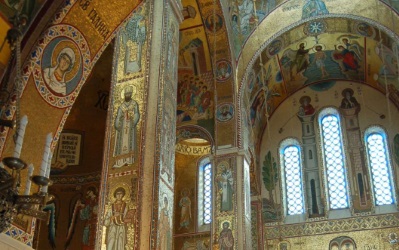ПРОПОВЕДЬ КОЛОНН
The Preaching of Columns
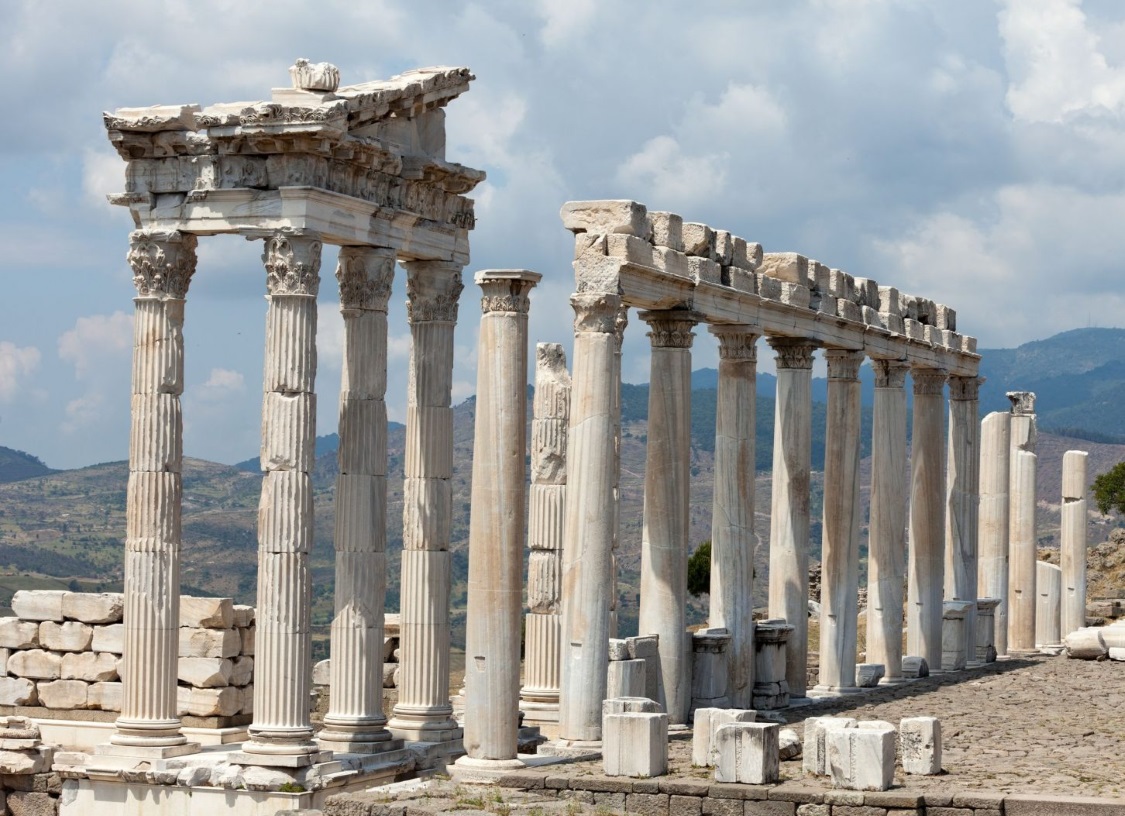

Columns of Pergamon, Turkey, one of the most outstanding examples of city planning in the ancient world with a library excelled only by that at Alexandria.
By Mary Lowell
(Click on images to enlarge.)
The artistic beauty of a building is not in the least a consequence of its perfect functionality. Principles of a purely artistic kind are decisive for the aesthetic value of a building. What beauty an arch can possess, or a tower in its form and color…! Dietrich von Hildebrand 1
It is common to hear people say, “I don’t need to go to church to worship God.” If God is “everywhere present and fills all things,” it is reasonable that we can worship Him anywhere. And, of course, this is true. But the logic may be less an affirmation of God’s omnipresence as a rejection of corporate worship. Minimizing the importance of uniting in worship to the point of absence has its corollary in Modernist architecture that “spiritualizes” worship space by emptying it.
Sanctuary of the Madonna delle Lacrime, Syracuse, Sicily (Photo: Fr. Ilya Gotlinsky)
Cathedral of the Madonna delle Lacrime, Syracuse, Sicily (Photo: Fr. Ilya Gotlinsky)
The Modernist doctrine of functionalism – function satisfies purpose – developed alongside new technologies and the various emergent movements of abstract art in the 19th century. As an architectural philosophy that ripened between world wars, it has influenced church building since at least the 1950s. Convinced that the more abstract is the more spiritual, Modernist architects of churches continue to create otherworldly vacuums that ignore the necessity of place for the human body.
This formless spirituality of poured concrete planes and exposed strut-work of chilly steel can easily serve as automobile show rooms and gymnasiums as they can places of worship. Like spacecraft from another dimension parked on earth, these omni-functional voids illustrate their designer’s indifference to the purpose of ecclesial structures. The only procedural question put to building committees is “What’s your target seating capacity?” 2
A Matter of Form
In Orthodox temple building, theological purpose defines function. And purpose takes a deliberate form, as with the “tabernacle in the wilderness” structured according to the pattern revealed to Moses on Mount Sinai.
Form per se makes things to be something rather than nothing; the richer the form the more real. James Matthew Wilson 3
Form is what makes things recognizable as “something” we can name, handle, and inhabit. Proportionality regulates form. Pythagoras, Euclid and subsequent mathematicians called the principle of proportionality the Golden Section or Divine Ratio. They used the order of constant relationships found in nature to develop an architectural language that carried over to Christian temple building and later to Islamic mosques.
It is truly astonishing that so many modern churches wholly deny the symbolic expression of sacred architecture. Roman architecture was taken up by the Church from a culture still awaiting the coming of Christ. But Modernist architecture is emblematic of a culture that has rejected Christ. Eschewing eternal truth, such a culture turns to its own fleeting and insecure definitions of happiness. Andrew Gould 4
Orthodox temple design, if planners are mindful of ideal proportions, begins with the Golden Section to scale every element to the whole, from the apse and iconostasis to dome and nave, including the entrance of natural light, and for the most part construction for Orthodox ecclesial purposes has resisted Modernist concepts of barren space in favor of meaningful form. Even so, temple building is susceptible to technological innovations that bypass features which have both structural and symbolic significance. For example, consider load bearing columns. With steel supports for vast blank expanses rendering structural columns unnecessary, Modernists typically dismiss their virtues for economic expediency and designers’ preference for voids.
Columns as a Testimony
Temple ruins on the acropolis at Pergamon, Turkey, period of Hadrian II, 125-128 BC. (Photo: Mary Lowell)
Holy Archangels Greek Orthodox Monastery, Kendalia, Texas. (Photo: Peter Papoutsis)
Columns of Greek and Roman temples, mostly all that remain standing or have been restored to upright majesty, still testify to the ghosts of their purpose. Poetically, they echoed the order of nature: hardy stone imitated the delicate botanical realm the way the trunks of trees hoist branches plumed with leaves. Anthropomorphically, stone emulated flesh in the ancient and universal attitude of prayer (orante) with arms uplifted beseeching heavenly mercies.
At the same time, columns declared a certainty of hierarchy in their supporting task as intermediaries between earth and heaven. Beholding topless ruins absent of load, we unconsciously re-vision the horizontal entablatures once upheld by columnar thrust.
While we disdain the vanquished dedications – the power of cult and imperial boasting of divine authority – that characterized pre-Christian civilizations, we share an artistic agency for conveying hierarchical realities. In pagan temples it was a pantheon of capricious ministries while in Christian temples it is the sovereignty of God made manifest in His Incarnation.
Columnar qualities of classical architecture incorporated in churches are not merely an interruption of the void to create majestic aspect. Columns establish ordered intervals akin to the mode of musical notation that raises expectations of glories to be revealed as one moves interiorly.
Church of the Holy New Martyrs and Confessors of Russia, Butovo. (Photo: Fr. Ilya Gotlinsky)
Pantocrator in dome of Cathedral in Monreale, Palermo, Sicily. (Photo: Fr. Ilya Gotlinsky)
The grander columns that support the dome’s mass stage the climax of the west to east orientation toward the altar.
As with their classical archetypes, the noble columns that support domes of Orthodox temples point to presences beyond the experience of our senses, for the intimate enclosure of ecclesial domes is not a ceiling. It is the representation of un-seeable heavens adorned with images of the Creator and Sustainer of All (Pantocrator), the angelic host, and the company of saints and martyrs.
The analogy is not so thin when we consider the objective as a kind of preaching. In temple building, the hierarchical pattern uniting earth with heaven fulfills the obligation to the worshiper to locate himself among the communion of saints in the presence of God. Though that locus transcends time and space, it is actualized here and now in stone and timber brought from afar.5
Why it Matters
Because there is serious confusion about what the Church is and thus the Christian temple, builders do not always approach the task understanding it.
The Greek word ekklesia, transliterated into English from the Germanic loan word kirche (church) is used in the New Testament to refer to “the assembly” of those “called out” to worship the One, True God. The Church is Christ’s Body, that is, the assembly of believers united to our Redeemer through baptism into His death and resurrection. The Church is both the local congregation and the whole of the faithful gathered together in worship throughout the visible and unseen worlds.
Yet, how can we by our limitations of nature, not being as God is in Himself (everywhere present and filling all things), assemble ourselves to worship Him? There must be a physical location where we come together to encounter Him among us: “I will declare thy name unto my brethren: in the midst of the congregation will I praise thee” (Psalm 22:22).
God, indeed, commanded the Hebrews to build a place of encounter: “And let them make me a sanctuary; that I may dwell among them” (Exodus 25: 8).
The “tent of meeting” that Moses constructed in the wilderness and the stationary temple that Solomon built on Mount Zion were not a necessity for God, for He has no necessity and does not “dwell in houses. (Isaiah 66:1). The temple was a provision for His people to meet Him “in the midst of the congregation” (Psalm 22:22).
Though a provision, the “sanctuary” was neither a casual shelter nor a fanciful palace. It was a realized vision of heaven itself. All its furnishings and artistic representations of angelic attendance embodied the ceremonies they served. Within, the beauty of psalmody was lifted in praise. Nothing was superfluous or purely decorative. Rather, it formed an ordained unity of purpose for “the assembly” to receive the presence of the God of Abraham, Isaac and Jacob.
The Sermon of Orthodox Temples
The obligation of Christian temple builders is no less. In truth, it is more because the temple is a visible evangel of the promise made to Abraham. The temple’s hierarchical arrangement of space proclaims the entirety of sacred history, from the first man Adam to the God-Man Jesus Christ conceived of the Holy Spirit and incarnate in the Virgin. The height of vaults and posture of walls, the textures and patterns of surfaces covered with icons, all are sermons of Very God become Very Man.
There is a basic misunderstanding: the assumption that the Church is obliged to stay in dialogue with contemporary culture as it has done throughout its history. The proposed “dialogue” is self-destructive, as it is based on an unreasonable inferiority complex vis-à-vis present-day intellectuals. This timidity may be justified by the poor grounding of some ecclesiastical representatives in the field of art. But the Church has no reason to be intimidated: until the nineteenth century, it had always held a pedagogic and not a submissive position as regarding men of culture, whom it educated in a formidable way. Ciro Lomonte 6
Resisting the New Iconoclasm
We suffer an age of redoubled iconoclasm. It is not the image-smashing in Constantinople, the Reformation rage against papist altars in Northern Europe, or the vandal-piety of Vatican II that plunders its own treasures. It is a militant renovation of the very meaning of beauty which shuns “the aesthetic value of a building” as belonging to an obsolete culture of symbolic frills.
Planners of Orthodox temples are not immune to function-first philosophies. It is evident in their choices of architects who know next-to-nothing about the heritage of ecclesial design, but also in their acceptance of materials that pretend to be something they are not. Faux outer claddings and sheet-rock interiors that ape solid masonry hardly give building committees pause. Regardless of the economic merits of which “look-alike” products brag, the illusion is inevitably discovered in their early disposability.
This was unimaginable for the builders of pagan temples, and for Christians before the 20th century. Having a rich “grounding” in “the field of art,” Christian builders chose the most sublime and durable materials to lift temples that were intended to remain as an embassy of the Kingdom of Heaven until the Second Coming. The irony that Christians, in supposedly the wealthiest nation in history, are satisfied to construct places of encounter with God from the cheapest wares available explains why it seems increasingly unnecessary “to go to church.” The backwoods and mountains are far more beckoning than structures that duplicate the loss of purpose experienced in secular life where everything constructed is destined to be razed.
Indications of Hope
Loadbearing columns of Holy Ascension Orthodox Church, Mt. Pleasant, S.C. (Photo: Andrew Gould)
View to the dome and choros of Holy Ascension Orthodox Church, Mt. Pleasant, S.C. (Photo: Andrew Gould)
There is growing movement among church designers who are attentive to human-scale proportionality and the sincerity of materials. Designers such as Duncan Stroik and Andrew Gould, with a deep knowledge of architectural and liturgical tradition, are proving that beautiful churches can still be built of honest goods worthy of their sacred intent. There is hope that parish members will embrace the rudiments of traditional ecclesial design with joy and shoulder the responsibility of making our churches an “icon of the Kingdom,” as did our forbearers who valued the wealth of God’s house above their own private mansions.
Protection of the Mother of God recently built in Yasenevo, Russia. (Photo: Fr. Ilya Gotlinsky)
]
Remember David, and all his afflictions: how he swore unto the Lord, and vowed unto the mighty God of Jacob; surely, I will not come into the tabernacle of my house, nor go up into my bed; I will not give sleep to mine eyes, or slumber to mine eyelids, until I find out a place for the Lord, an habitation for the mighty God of Jacob (Psalm 132:1-4).
If the preaching-beauty of our architectural heritage no longer means anything in Modernist vocabularies other than decorative extravagance, Orthodox priests and their people must sustain these wordless witnesses that the Kingdom has come among us, standing strong as load-bearing columns against “the foolish man, which built his house upon the sand” (Matthew 7: 26).
FOOTNOTES
1 Dietrich von Hildebrand. “The Second Theme of Architecture: Artistic Beauty.” Institute for Sacred Architecture, Vol 30. http://www.sacredarchitecture.org/articles/the_second_theme_of_architecture_artistic_beauty
2 Seating-space was never a consideration in Orthodox temples, nor in Western churches until the Reformation when lectures replaced liturgics. Regrettably, the fashion has taken hold in some Orthodox quarters, even the fan-shaped seating of “church-in-the-round.” This is an odd but widespread phenomenon in American Orthodoxy, odd in that liturgy (leitourgia) is the “work of the people” and not a clerical performance passively observed from a comfortably seated position.
3 James Matthew Wilson. “The Fortunes of Poetry in an age of unmaking.” Wiseblood Books, p. 115
4 Andrew Gould. “An Icon of the Kingdom of God: The Integrated Expression of all the Liturgical Arts – Part 4 on Architecture” (Orthodox Arts Journal) https://www.orthodoxartsjournal.org/an-icon-of-the-kingdom-of-god-the-integrated-expression-of-all-the-liturgical-arts-part-4-architecture/
5 “And, behold, I purpose to build an house unto the name of the Lord my God, as the Lord spake unto David my father, saying, Thy son, whom I will set upon thy throne in thy room, he shall build an house unto my name. Now therefore command thou that they hew me cedar trees out of Lebanon …” I Kings 5: 5, 6
6 Ciro Lomonte. “Why Modernist Architecture is Not Suitable for the Liturgy.” Institute for Sacred Architecture, Vol 30. http://www.sacredarchitecture.org/articles/starting_again_from_zero
Duncan Stroik is professor of Architecture at the University of Notre Dame School of Architecture, and founding editor of the Sacred Architecture Journal. His work continues the tradition of classical and Palladian architecture, also known as New Classical Architecture.
Andrew Gould is a well-known designer of Orthodox Churches and a leader of traditional design in urbanism. He is the founder of New World Byzantine Studios, a cooperative for the manufacture of traditional Orthodox arts. Gould is also the founder of the Orthodox Arts Journal.





